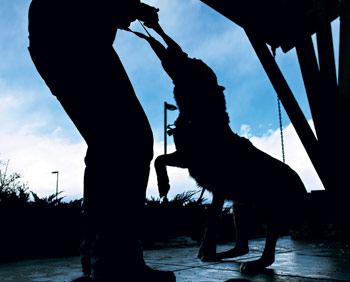In the ongoing battle to defend a pristine watershed against aquatic invasive species, the Flathead Basin is gaining a new four-legged resource.
Pepin, an 8-year-old Belgian malinois, is a trained detection dog and one of the finest conservation canines in the world. Using his keen sense of smell, Pepin has traveled to 12 countries and helped researchers locate the most elusive endangered species, discovered nonnative plants and invertebrates and sniffed out dangerous hazards like toxic chemicals or metal snares hidden to the human eye.
Now his expertise is being brought to Northwest Montana, where invasive plants and mussels pose a constant and critical threat to the region’s rivers and lakes.
“If detection dogs can help we’d like to be part of that,” said Pete Coppolillo, executive director of Working Dogs for Conservation, an organization based in Bozeman that became one of the first to train detection dogs when it was founded by four biologists in 2000.
Coppolillo and Meg Parker, the director of research at WDC, introduced Pepin and his innovative abilities at last week’s Flathead Basin Commission meeting in Kalispell. The commission, established by the Legislature in 1983 as a task force for protecting the water quality of the Flathead River drainage, plans to use Pepin for 10 days this summer at local check stations where boats are inspected. It will be a trial run for a possible permanent program in the future that would establish a regular team of detection dogs sniffing out miniscule aquatic invasive species like zebra and quagga mussels that cling to boats. Two other states, California and Minnesota, have created similar AIS detection dog programs.
“I think this is an excellent idea and it’s certainly worth experimenting with and seeing how effective it is,” said Chas Cartwright, the commission’s chair and former superintendent of Glacier National Park. “It’s pretty clear to me that they are better at detecting than people. So why not augment people with dogs?”
As Cartwright and others discovered, detection dogs like Pepin have an uncanny attention to details. WDC has trained its dogs to learn as many as 19 different scents, from wildlife scat to fish species that leave traces that can be picked up by the slightest of odors, even on water. Pepin recently returned from Zambia where he helped locate wire snares hidden in the safari, an unprecedented solution for managers. He’s also traced wolverines, grizzly bears and wolves by their droppings, helping scientists study the genetic makeup, population densities and range of hard-to-find species. The same goes for plants or tiny insects, such as an invasive slug in Hawaii that Pepin has unearthed. Detection dogs have even been trained to sense diseases like brucellosis in bison.
“Humans are crippled by their eyes,” Parker said. “(The detection dogs) use their nose to do things we couldn’t possibly do.”
Instead of seeking out top-notch breeders, the WDC team of wildlife experts and trainers tries to find canines from animal shelters across the state. An estimated one in roughly 1,000 dogs is cut out for detection duties. They must undergo a rigorous training regimen using methods developed from narcotic, forensic and search and rescue techniques. Specifically, WDC trainers teach the dogs to associate the odor of a target with a reward.
“It’s his greatest joy,” Parker said of Pepin. “These dogs love to work.”
WDC currently has seven dogs of different breeds trained in an array of smells.
 |
|
Working Dogs for Conservation’s Belgian Malinois, Pepin, tugs a toy from his handler, Megan Parker. – Greg Lindstrom | Flathead Beacon |
The Flathead Basin Commission hopes that Pepin and others could help stop a looming disaster. Invasive mollusks have colonized lakes across the U.S. with devastating effects. They have caused millions of dollars in cleanup and repair costs in the Northeast, Midwest, and Southwest regions of the United States, but have yet to find their way into the Northwest. In 2007, Lake Mead became the first documented infestation west of the Rockies. Mussels are quick to reproduce and can clog intake pipes and damage piers and, perhaps most significantly, disrupt whole ecosystems.
Last year the Montana Legislature beefed up the state’s AIS law and boosted funding for resources like check stations at key entry sites for boaters. There are 20 check stations across the state, including nine in the Flathead Valley, that are staffed by nearly 70 inspectors during the peak summer season.
The hope is that detection dogs could provide a valuable resource for sniffing out AIS while raising education and awareness of the issue by being a noticeable figure in the fight.
“It’s an amazing opportunity and I would love for this to be a model for the state,” said Coppolillo.